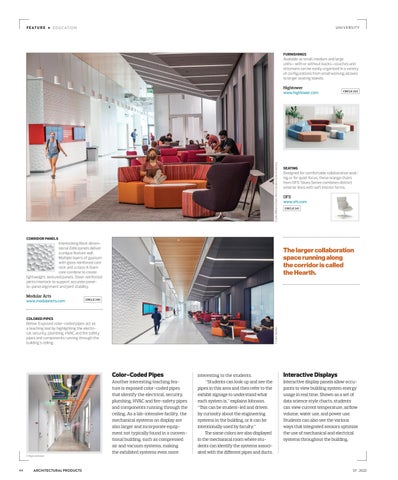F E AT U R E
u
UNIVERSIT Y
E D U C AT I O N
FURNISHINGS
Available as small, medium and large units—with or without backs—couches and ottomans can be easily organized in a variety of configurations from small working alcoves to larger seating islands.
Hightower
© Julie Williams Dixon/North Carolina State University
www.hightower.com
CIRCLE 242
SEATING
Designed for comfortable collaborative seating or for quiet focus, these orange chairs from OFS’ Skara Series combines distinct exterior lines with soft interior forms.
OFS
www.ofs.com CIRCLE 241
CORRIDOR PANELS
Interlocking Rock dimensional Zelle panels deliver a unique feature wall. Multiple layers of gypsum with glass reinforced cast rock and a class A foam core combine to create lightweight, textured panels. Steel-reinforced joints interlock to support accurate panelto-panel alignment and joint stability.
Modular Arts
www.modulararts.com
The larger collaboration space running along the corridor is called the Hearth.
CIRCLE 240
COLORED PIPES
© Clark Nexsen
Below: Exposed color-coded pipes act as a teaching tool by highlighting the electrical, security, plumbing, HVAC and fire safety pipes and components running through the building’s ceiling.
Color-Coded Pipes
© Ryan Johnson
44
ARCHITECTURAL PRODUCTS
2207APFEA03.indd 44
Another interesting teaching feature is exposed color-coded pipes that identify the electrical, security, plumbing, HVAC and fire-safety pipes and components running through the ceiling. As a lab-intensive facility, the mechanical systems on display are also larger and incorporate equipment not typically found in a conventional building, such as compressed air and vacuum systems, making the exhibited systems even more
interesting to the students. “Students can look up and see the pipes in this area and then refer to the exhibit signage to understand what each system is,” explains Johnson. “This can be student-led and driven by curiosity about the engineering systems in the building, or it can be intentionally used by faculty.” The same colors are also displayed in the mechanical room where students can identify the systems associated with the different pipes and ducts.
Interactive Displays Interactive display panels allow occupants to view building system energy usage in real time. Shown as a set of data science style charts, students can view current temperature, airflow volume, water use, and power use. Students can also see the various ways that integrated sensors optimize the use of mechanical and electrical systems throughout the building.
07 . 2022
7/25/22 5:17 PM




